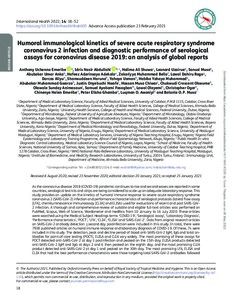Humoral immunological kinetics of severe acute respiratory syndrome coronavirus 2 infection and diagnostic performance of serological assays for coronavirus disease 2019: an analysis of global reports
Emeribe Anthony Uchenna; Abdullahi Idris Nasir; Shuwa Halima Ali; Uzairue Leonard; Musa Sanusi; Anka Abubakar Umar; Adekola Hafeez Aderinsayo; Bello Zakariyya Muhammad; Rogo Lawal Dahiru; Aliyu Dorcas; Haruna Shamsuddeen; Usman Yahaya; Muhammad Habiba Yahaya; Gwarzo Abubakar Muhammad; Nwofe Justin Onyebuchi; Chiwar Hassan Musa; Okwume Chukwudi Crescent; Animasaun Olawale Sunday; Fasogbon Samuel Ayobami; Olayemi Lawal; Ogar Christopher; Emeribe Chinenye Helen; Ghamba Peter Elisha; Awoniyi Luqman O; Musa Bolanie OP
Humoral immunological kinetics of severe acute respiratory syndrome coronavirus 2 infection and diagnostic performance of serological assays for coronavirus disease 2019: an analysis of global reports
Emeribe Anthony Uchenna
Abdullahi Idris Nasir
Shuwa Halima Ali
Uzairue Leonard
Musa Sanusi
Anka Abubakar Umar
Adekola Hafeez Aderinsayo
Bello Zakariyya Muhammad
Rogo Lawal Dahiru
Aliyu Dorcas
Haruna Shamsuddeen
Usman Yahaya
Muhammad Habiba Yahaya
Gwarzo Abubakar Muhammad
Nwofe Justin Onyebuchi
Chiwar Hassan Musa
Okwume Chukwudi Crescent
Animasaun Olawale Sunday
Fasogbon Samuel Ayobami
Olayemi Lawal
Ogar Christopher
Emeribe Chinenye Helen
Ghamba Peter Elisha
Awoniyi Luqman O
Musa Bolanie OP
OXFORD UNIV PRESS
Julkaisun pysyvä osoite on:
https://urn.fi/URN:NBN:fi-fe2022081154188
https://urn.fi/URN:NBN:fi-fe2022081154188
Tiivistelmä
As the coronavirus disease 2019 (COVID-19) pandemic continues to rise and second waves are reported in some countries, serological test kits and strips are being considered to scale up an adequate laboratory response. This study provides an update on the kinetics of humoral immune response to severe acute respiratory syndrome coronavirus 2 (SARS-CoV-2) infection and performance characteristics of serological protocols (lateral flow assay [LFA], chemiluminescence immunoassay [CLIA] and ELISA) used for evaluations of recent and past SARS-CoV-2 infection. A thorough and comprehensive review of suitable and eligible full-text articles was performed on PubMed, Scopus, Web of Science, Wordometer and medRxiv from 10 January to 16 July 2020. These articles were searched using the Medical Subject Headings terms 'COVID-19', 'Serological assay', 'Laboratory Diagnosis', 'Performance characteristics', 'POCT', 'LFA', 'CLIA', 'ELISA' and 'SARS-CoV-2'. Data from original research articles on SARS-CoV-2 antibody detection >= second day postinfection were included in this study. In total, there were 7938 published articles on humoral immune response and laboratory diagnosis of COVID-19. Of these, 74 were included in this study. The detection, peak and decline period of blood anti-SARS-CoV-2 IgM, IgG and total antibodies for point-of-care testing (POCT), ELISA and CLIA vary widely. The most promising of these assays for POCT detected anti-SARS-CoV-2 at day 3 postinfection and peaked on the 15th day; ELISA products detected anti-SARS-CoV-2 IgM and IgG at days 2 and 6 then peaked on the eighth day; and the most promising CLIA product detected anti-SARS-CoV-2 at day 1 and peaked on the 30th day. The most promising LFA, ELISA and CLIA that had the best performance characteristics were those targeting total SARS-CoV-2 antibodies followed by those targeting anti-SARS-CoV-2 IgG then IgM. Essentially, the CLIA-based SARS-CoV-2 tests had the best performance characteristics, followed by ELISA then POCT. Given the varied performance characteristics of all the serological assays, there is a need to continuously improve their detection thresholds, as well as to monitor and re-evaluate their performances to assure their significance and applicability for COVID-19 clinical and epidemiological purposes.
Kokoelmat
- Rinnakkaistallenteet [27094]
